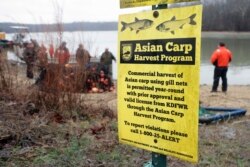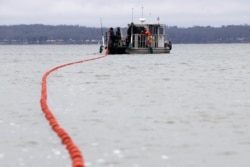Wildlife officials at a lake in Kentucky recently used electric shocks and sound to lead huge groups of Asian carp into large nets.
This was the latest effort in a 15-year battle to halt the spread of the fish in the United States.
The Asian carp is an invasive species that threatens to damage underwater ecosystems. The carp compete for food that native fish eat. They are also blamed for harming endangered mussels and snails along the Mississippi River and other waterways.
The Associated Press, or AP, examined data from state and federal agencies about the cost of efforts against Asian carp. The AP found that together they have spent nearly $607 million to stop the fish since 2004. Proposed projects are expected to increase that cost to about $1.5 billion over the next 10 years.
That is more than five times the amount predicted in 2007 when a national carp management plan was created. Programs aim to reduce established populations and prevent further spreading. But wildlife officials admit they may never be able to stop the fish.
Much has been done to limit the carps’ movement northward and to keep them out of the Great Lakes. Experts say they could severely damage the fishing industry in those bodies of water. The effort includes a proposed underwater electric barrier near Chicago and genetic testing. It also includes payments to commercial fishers and other experiments to harvest the fish.
The effort has mostly been successful, yet the lakes remain at risk and grass carp have been identified in Lake Erie, Lake Ontario and Lake Michigan.
Less money and attention have gone to the carp’s nearly unlimited spread east and west into the Missouri and Ohio rivers.
The term “Asian carp” describes four different species: bighead, black, grass and silver carp. The carp were imported to the U.S. in the 1960s and 1970s as a way to deal with unwanted water plants and parasites. But the fish escaped into many American waterways.
Joel Brammeier is president of the activist group Alliance for the Great Lakes. He said, “…Biologists understood the risks of bringing live, non-native animals into the country. It should never have happened.”
Greg Conover is a U.S. Fish and Wildlife Service biologist. He oversaw the development of the national Asian carp plan. He saw how many there were in the Mississippi River as he studied native paddlefish in the 1990s.
“At first there were no carp, then we were catching a few carp here and there, then eventually we were filling the nets with carp and no paddlefish,” he said.
Scientists say that Asian carp in the upper Mississippi River are pushing out valuable native fish such as yellow perch and bluegill. And people who fish for sport say they are seeing the effects.
Kevin Irons is with the Illinois Department of Natural Resources. He said control efforts have been successful in the parts of the Illinois and Des Plaines rivers. He noted that a combination of methods including commercial fishing have removed hundreds of thousands of kilograms of fish from those rivers close to Lake Michigan.
To prevent carp from moving northward into Lake Michigan, the U.S. Army Corps of Engineers is proposing the most costly effort to date. It is an electric barrier near Chicago that also would produce air and noise underwater. Congress is considering the plan which would cost more than $800 million.
At the same time, southern states are increasing efforts to control the fish. Tennessee hired its first aquatic nuisance species coordinator in December. In Kentucky, officials put in place an experimental underwater barrier last November designed to block Asian carp at a lake on the border of Kentucky and Tennessee.
I’m Alice Bryant.
And I’m Pete Musto.
Travis Loller and John Flesher reported this story for the Associated Press. Pete Musto adapted it for VOA Learning English. Mario Ritter, Jr. was the editor. Write to us in the Comments Section or on our Facebook page.
_________________________________________________
Words in This Story
net(s) – n. a device that is used for catching or holding things or for keeping things out of a space and that is made of pieces of string, rope or wire linked together with spaces in between
invasive – adj. likely to spread
species – n. a group of animals or plants that are similar and can produce young animals or plants
ecosystem(s) – n. everything that exists in a given environment
management – n. the act or skill of controlling and making decisions about a business, department or sports team
commercial – adj. related to or used in the buying and selling of goods and services
parasite(s) – n. an animal or plant that lives in or on another animal or plant and gets food or protection from it
eventually – adv. at some later time
aquatic – adj. living or found in or near water
nuisance – n. a person, thing, or situation that is annoying or that causes trouble or problems









